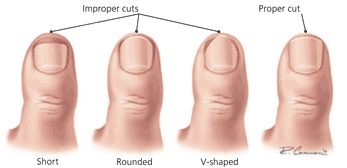What are ingrown toenails (Onychocryptosis)?
When a toenail is ingrown, it is curved and grows into the surrounding skin as the nail grows out. This ingrowing of the nail irritates the skin, often creating pain, redness, swelling, and warmth in the toe.
If an ingrown nail causes a break in the skin, bacteria may enter and cause an infection in the area, which is often marked by fluid, redness and pus. Infection often occurs with ingrown toenails due to the surrounding environment of the toe, where exposure to sweat, dirt and debris is common.
Signs and Symptoms
- Pain along the side of the nail
- Redness of the bordering skin
- Warmth of the toe
- Swelling of the toe
- Drainage of pus or fluid, indicating infection
- Excessively curved nail
Causes of ingrown toenails
- Improper trimming. The most common cause of ingrown toenails is cutting your nails too short. This encourages the skin next to the nail to fold over the nail.
- Heredity. In many people, the tendency for ingrown toenails is inherited. The curvature of the nail is often what is ‘passed down’ from your parent.
- Trauma. Sometimes an ingrown toenail is the result of trauma, such as stubbing your toe, having an object fall on your toe, or engaging in activities that involve repeated pressure on the toes, such as kicking or running.
- Improperly sized footwear. Ingrown toenails can result from wearing socks and shoes that are tight or short.
- Nail Conditions. Ingrown toenails can be caused by nail problems, such as fungal infections.
Treatment of ingrown toenails
Sometimes initial treatment for ingrown toenails can be safely performed at home. However, home treatment is strongly discouraged if an infection is suspected, or for those who have medical conditions that put feet at high risk, such as diabetes, nerve damage in the foot, or poor circulation. If this is the case, it is extremely important that you seek the medical attention from a podiatrist.
If an ingrown toenail has caused an infection, antibiotics may be recommended. Although antibiotics may help reduce the infection, they will not help with addressing the cause of the infection. The best way to reduce the pain of an ingrown toenail and the associated infection is to have the irritating portion of the nail removed by a podiatrist. If this irritation is not removed, then infections (and pain) caused by ingrown toenails often return.
Podiatrists can help by removing the offending nail spicule, cutting and filing the nail to promote the nail to grow out past the skin fold and prevent reoccurrence by giving you advice on the correct cutting technique and preventative measures. In severe cases where the problem keeps occurring, minor surgery may be performed. This is known as a Partial Nail Avulsion (PNA). This procedure is carried out under local anaesthetic whereby a portion of the nail is removed and a chemical is used to prevent reoccurrence.
Preventing ingrown toenails
Most cases of ingrown toenails can be prevented by:
- Proper trimming. Cut toenails in a fairly straight line, and don’t cut them too short. You should be able to get your fingernail under the sides and end of the nail.
- Well-fitted shoes and socks. Don’t wear shoes that are short or tight in the toe area. Avoid shoes that are loose, because they too cause pressure on the toes, especially when running or walking briskly.
The do not’s of home treatment for ingrown toenails.
- Do not cut a notch or ‘V’ in the nail. Contrary to what some people believe, this does not reduce the tendency for the nail to curve downward.
- Do not repeatedly trim nail borders. Repeated trimming does not change the way the nail grows, and can make the condition worse.
- Do not place cotton under the nail. Not only does this not relieve the pain, it provides a place for harmful bacteria to grow, resulting in infection.
- Over-the-counter medications do not work. Topical medications may mask the pain, but they do not correct the underlying problem.










